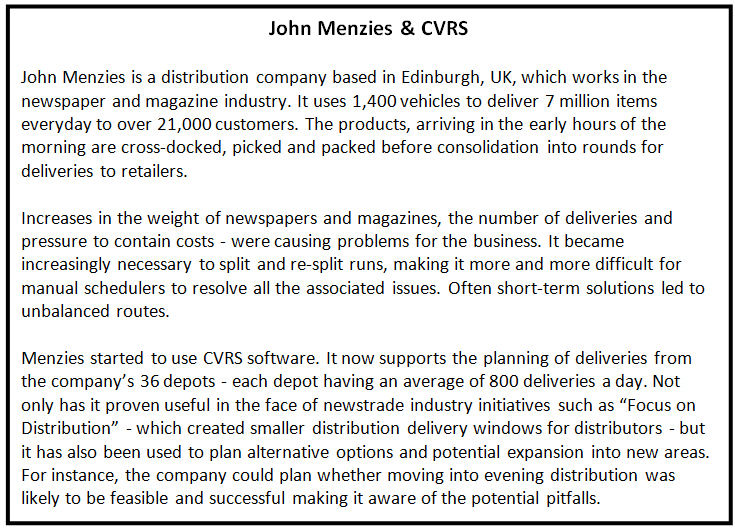
Road Network Operations
& Intelligent Transport Systems
A guide for practitioners!

Road Network Operations
& Intelligent Transport Systems
A guide for practitioners!
Whatever the shape or nature of the supply chain, routing and scheduling systems seek to reduce wasted vehicle and driver time and to maximise utilisation whilst reducing costs associated with mileage and fuel-spend. This often delivers additional benefits such as a more environmentally friendly supply chain.
Computerised Vehicle Routing and Scheduling (CVRS) software normally comes in two different varieties: offline and online. Traditionally the offline services offer more functionality than the online cloud-based systems. A frequently cited indicator of performance for offline CVRS systems is that, when used effectively, they offer a 10% improvement in routing and scheduling efficiency compared to manual methods.
Offline systems tend to be used by larger fleets (eg over 10 vehicles), as normally the purchasing of the software and the licensing costs are prohibitive for smaller fleets. The advantage of such software is that it offers complete control over the process, with opportunities to specialise the process given the requirements of the fleet in question.
Smaller firms tend to use online-based CVRS, where the software and the processing happens off-site “in the cloud”. These tend (although not necessarily) to have less customisation opportunities than their offline counterparts, but come with significantly lower costs.
The CVRS software takes into account all collection and delivery information before providing the optimum solution for a specific set of parameters which control the way the transport operation is managed. Parameters could include criteria such as road speeds and restrictions, load size, customer opening times/delivery windows and driver hours. CVRS systems can provide daily, weekly or monthly plans. Many also offer a strategic dimension, allowing for alternative approaches to be “trialled” in the system – to explore what the potential outcomes might be. For example, if a large customer is taken on board, what factors in the transport operation would need to be changed to meet the customer’s requirements.

CVRS is not a replacement for manual planning. It is best used in conjunction with manual planners. The first iteration of routes often needs adjusting to reflect the local knowledge of the planner to deal with issues such as rush hour (although some programmes take this into account) or known restrictions on delivery times and routes. All scheduling systems are reliant on electronic maps and only as good as the map they use. Whilst some systems are updated by the manufacturer, not all are, so it is important to ensure that any changes in road layout or road restrictions is reflected. This is particularly an issue in developing countries.
Routing and scheduling is a very dynamic field which is constantly changing and progressing, in terms of technology, enforcement and organisation:
Routes configured through the use of CVRS have traditionally been downloaded to drivers’ PDA’s for the following day. However these can now be updated “on-the-fly” to take account of changing factors such as avoid road disruption, incidents or congestion or cancellation or re-scheduling a delivery – to provide automatic re-routing. Much of the work that was done by PDA’s during the initial iteration of CVRS software is now being replaced by Sat-Navs and smartphones. (See Traveller Services and Enabling Technologies)
Concerns about congestion and pollution on road networks is generating a number of innovative solutions. One is Freight Consolidation Centres (FCCs), which utilise CVRS intensely. Another is the increase in measures to prevent freight lorries from impinging on the quality of life of others. These include:
CVRS can seem an expensive solution but the principles on which they are based are relevant to all routeing and scheduling decisions - namely the need to minimise costs and resource expenditure by optimising the use of assets. With rapidly developing road networks or very changeable road network conditions, the local knowledge of the planner is even more important than where networks are well-mapped and the mapping is reliable. (See Just in Time) Online options offer lower costs and are also more flexible when it comes to switching if maps prove not to be of sufficient quality.